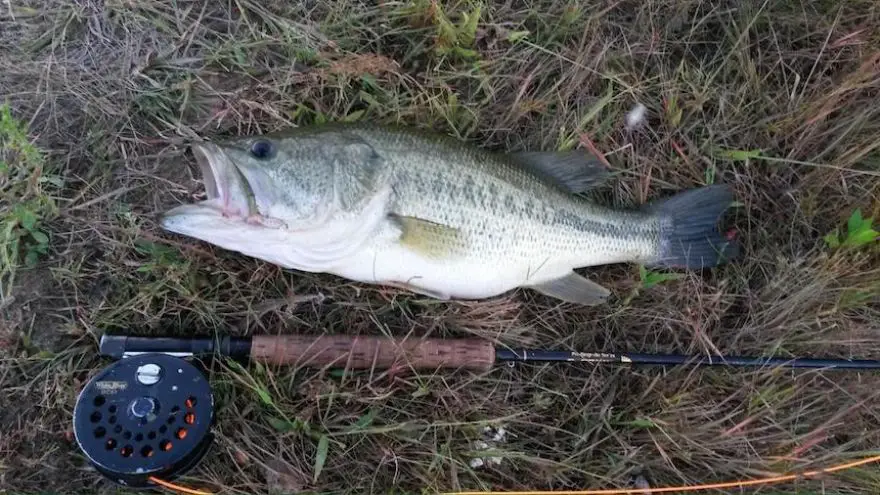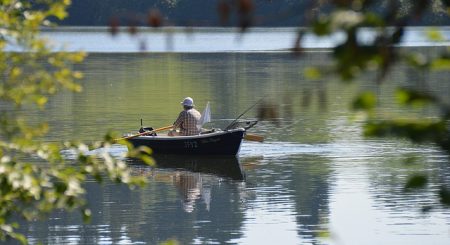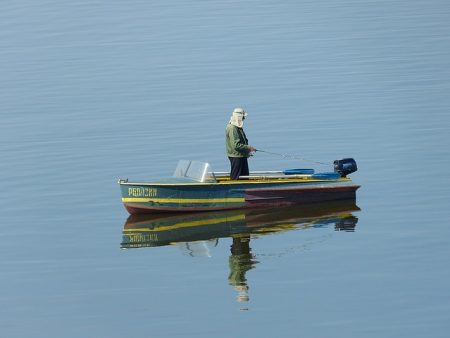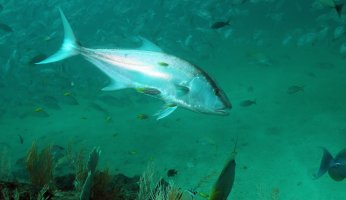Bass on the Fly
 Bass on the Fly
gearweare.net
Bass on the Fly
gearweare.net
Fly fishing is subtle. Even if you’ve never fly fished you know this because Hollywood and the outdoor shows have proven it to us. As the sun is peeking over the mountains to begin a new day, the fly fisherman creeps slowly up to the water’s edge. He crouches next to the small stream, for what seems to be several minutes. We watch breathlessly as he scans the pool in front of him for any signs of fish activity. He very much resembles a hunter that is stalking a dangerous animal.

Finally, the fisherman stands up next to the water, his eyes fixed on some target on the stream that we can’t see yet, and with a grace and beauty that can only be surpassed by a figure skater, he raises his fly rod and begins his cast. The line behind him nearly spells out the letters “F I S H” as he finally allows his fly to land directly over a large Rainbow trout that we only now see, as it ‘slurps’ his dry fly into its mouth.
Unfortunately, most of America does not live in a part of the country that would allow us to play out this scene in our own lives. Most of us live in areas that are either too warm for native trout or if we do have some, they are so small that we would feel ridiculous attempting to hook such small mouths on a fly. The good news is that we don’t have to.
Fly fishing is nothing more than a different way to present a lure. That’s all. Brad Pitt and his river aside, you can pursue any fish on the planet with a fly rod and not feel silly walking around like Inspector Gadget (if you’re old enough to remember that cartoon!), with all of the fly fishing accoutrements hanging from your vest.
Bass in Spring
In fact, Spring is a great time to pick up a fly rod and pursue bass. Speaking for myself, this was the reason I got into fly fishing to begin with. I was weary of feeling like I was missing something fun, simply because I didn’t own property on the River Runs Through It. I will try to make the argument that a fly rod, in early spring, is your best presentation for cold, slow moving, fish.

Blind casting a fly rod can become tedious quickly. The purists of the sport will tell you that fly fishing is a visual sport and that it was designed to be used on fish that you can see, not blind casting at rocks and stumps. Having said that, have you ever tried fly fishing from the comfortable seat on your bass boat? It’s not as crazy as it sounds.
How to do it
It’s very easy to cast a rod from a boat seat. Oh, it will feel awkward at first but you’ll soon get the hang of it. It’s a very simple ‘pick-up cast’ that continuously flips your line back at the bank while your foot rests on the trolling motor and controls the boat. It can also be deadly accurate in bass fishing. This is a very easy way to defeat the tediousness of blind casting. Think less “make it do something” as you do in spincast fishing and think more about “let it sink”.

For pre-spawn bass, it is that ‘sink’ that gets them. We all recognize that lures have to move slowly in cold water in order to give these lethargic fish time to see, get to, and respond to our lure. Fly fishing solves all of that because of the slow, vertical drop presented as the fly continues to sink. Most of the time, fish won’t even have to pursue it. If you are casting at cover, the fly will sink right in front of their nose.
The take will be subtle but usually they are reluctant to let go of it, once they have it, so you have a few seconds to detect it. Often it will simply be a pressure on your line that wasn’t there before. It won’t be until the water warms up some that they nearly yank the fly rod out of your hand. The fish we are targeting with this approach are the big, still deep, females that are not ready to spawn but are not going to turn down an easy meal either.
Your tackle will be dependent on the size of the fish that you think you are contending with, but I like a 5 wt or a 6 wt outfit with an 8 or 10 pound leader. I don’t use trout tippets on bass because I don’t need to. Just an average length, 5′ or so, of straight monofilament line is perfect.
In the early spring, you’ll want to let this sink as long as you can and as deep as you can. It might even be beneficial to have a spool of intermediate sinking line on hand to help get your fly deep. I use regular floating line but make certain that I cast flies that have weight on them. I prefer dumbell eyes over bead heads simply because they are heavier. Any heavy streamer will do as long as it sinks and begins pulling your floating line down behind it.

Cast, let it sink, strip it in quickly and repeat. It’s not so much blind casting as blind jigging, without the jig. You will most likely not realize there is a fish holding your fly until you begin to strip it in and that’s when you’ll feel the pressure. You may even assume that you’ve become snagged on something but set the hook anyway. You’ll be amazed at how many ‘snags’ turn out to be bass.
Some of my favorite flies to use for this are mop flies. Wooly buggers work well too as will any insect imitation. Keep in mind that just because a fly is in the streamer category, this does not mean that it has to be stripped in for it to work. Bass are quite accustomed to seeing dying minnows drop from above their heads.
Fly fishermen understand well that a lure does not have to snap, crackle or pop in order to induce a strike from a fish. This is sometimes a difficult concept for bass anglers with spinning gear to understand. This is not surprising given that every lure being sold today claims to move differently and provide action that others do not. We can use this subtle approach of fly fishing to catching more bass, however, and that’s why you need a fly rod.
I once experimented on my boat, using a handmade mop fly that I knew that the smallies liked. I knew this because I had already caught several with a fly rod. I put the same fly on a light bailcasting reel and added just enough weight to get it to cast without tangling the line. Nothing. Not one bite. I removed everything from the line except the fly and, fighting a tangle every time I threw it, began connecting with fish again! Clearly it was the speed of the fly’s drop that was the trigger.
Give it a try this spring. I think in a few years you are going to see more and more of a blur between fly fishing and spincasting as anglers begin adapting both types to their efforts and because of the unique advantages that both offer. A fly rod will, one day, be just be another tool to catch fish and then hopefully everyone on the river will stop staring at me when they see me swinging a fly rod from my bass boat. 🙂 If you want to know more about catching this fish, read our article on how to catch bass in the winter.













